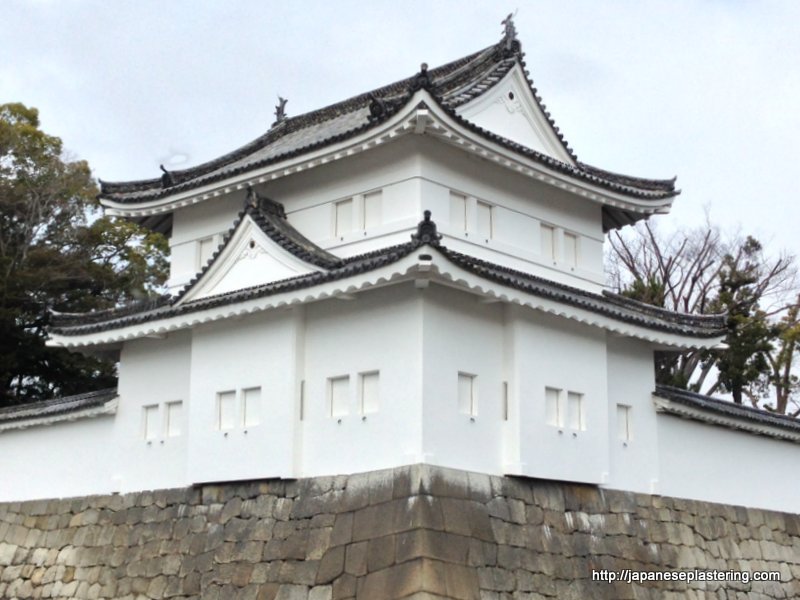Japanese Plasters
Following the spread of Buddhism, lime plaster was first introduced to Japan from the Korean Peninsula in the 6th century. The original purpose was to provide a canvas for religious paintings. When lime plaster was first introduced to Japan, paper fibers were mostly likely used in place of hemp.
Traditionally, the manufacturing of lime was energy intensive and lime was a valuable commodity in pre-industrial Japan. Therefore, it was used very sparingly. Japanese lime finishes are usually applied a few millimeter thick over an earthen plaster, and in some cases, over a sand-lime plaster. Their primary function is to protect earthen plastered walls from rain erosion. Depending on exposure, the lifespan of exterior Japanese lime plaster over earth is about 20 years. In this sense, it is a kind of sacrificial layer protecting a bamboo lattice and earthen plastered wall that will last over one-hundred years.
Japanese lime plaster was developed to allow large, uninterrupted earthen walls to be finished without joints. That is, by improving workability and moisture retention, Japanese lime plaster allows for the walls of castles and earthen store houses to be finished without interruption, so there are no joints in the finish plaster.
Since Japanese lime plaster is often applied very thinly over a very large area, it must maintain its workability and delay hardening until the entire wall can be finished. In order to increase moisture retention and delay set-up, seaweed glues were added to hydrated lime. The seaweed glue retains moisture and delays hardening, which improves workability.
Traditional Japanese lime plasters consist of hydrated lime, seaweed glue, and plant fibers. Kiwado Plasters are produced from natural ingredients under strict ecological standards. The following describes the production of Kiwado Plasters.
Natural Lime
Through a chemical reaction with the carbon dioxide in the air, hydrated lime returns to limestone and provides a recalcitrant, weather resistant and dust free finish.
One of Japan's most plentiful natural resources is lime stone.
Pure lime stone results in a pure white lime.
Coke fuel, containing few impurities and high carbon content, is used to fire lime stone to about 1,000°C.
One special characteristic of Japanese lime plasters is that salt is mix with lime stone before firing. Through the addition of salt, less water is required to make the finish plaster workable. When less water is included in the plaster, less water evaporates during curing, which in turn reduces cracking and increases strength.
Through the firing process, carbon dioxide is driven off from calcium hydroxide, leaving calcium oxide (quicklime).
CaCO3 + heat → CaO + CO2
After firing, the quick lime is hand picked, removing under-fired lime, over-fired lime and fuel remains, leaving a pure quick lime. The quicklime is then hydrated, that is combined with water, also known as slaking. Thus, hydrated lime is also known as slaked lime.
CaO + H2O → Ca(OH)2
Seaweed Glue
Non-edible seaweed is boiled to produce a starch glue. The addition of seaweed glue increases adhesion and improves workability, that is, increases moisture retention and delays setup so that the plaster can be worked longer. (Seaweed glues are also added in earthen plasters for the same reason.) The addition of seaweed glue also reduces the amount of water needed to make a plaster workable, which reduces evaporation after application, and in turn reduces cracking and improves strength.
Seaweed is boiled creating a liquid starch glue.
The starch glue is filtered and dried creating a dry, powder seaweed glue.
Jute Fibers
The use of jute fibers increases bending and tensile strength and reduces cracking. Traditionally hemp fibers were used.
Kiwado Plasters
Kiwado Plasters use these natural ingredients, creating a healthy living environment while being light on the earth.
(1) Building upon 400 years of tradition, Kiwado NAGOMI is a time honored Japanese lime plaster consisting of hydrated lime, plant fibers and seaweed glue.
(2) Kiwado HIKARI is Kiwado's finest lime plaster and polishes easily.
(3) Kiwado OTSU is a classic earth-lime finish traditionally used in entrance ways and anywhere a more durable, yet unimposing finish is desired.
(4) Consisting of 50% diatomaceous earth, Kiwado IBUKI provides the highest indoor air quality and is recommended for critical areas such as bedrooms and bathrooms. Due to special geological processes, the pores of Japanese diatomite are uncharacteristically small, creating an incredible ability to moderate humidity and absorb VOCs.















